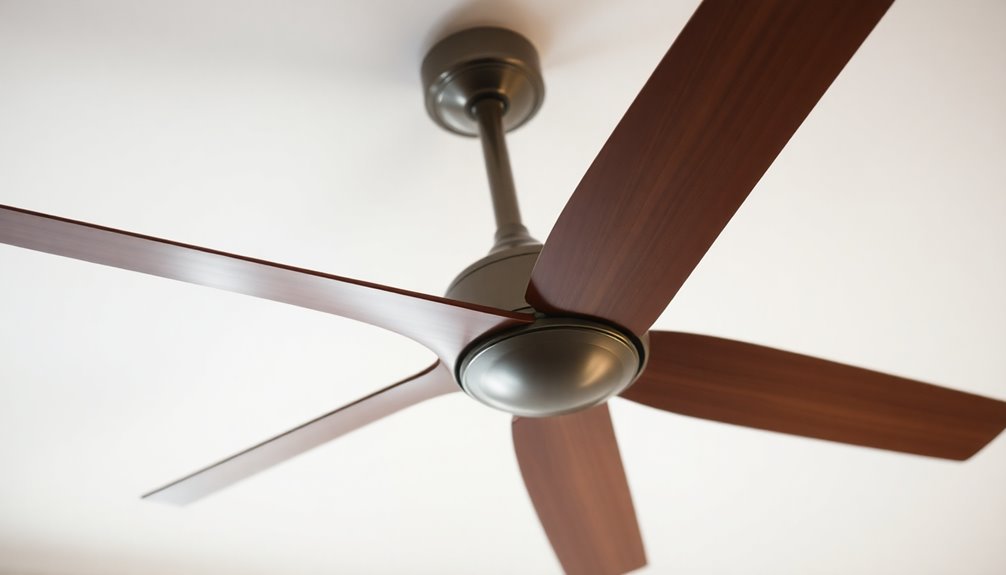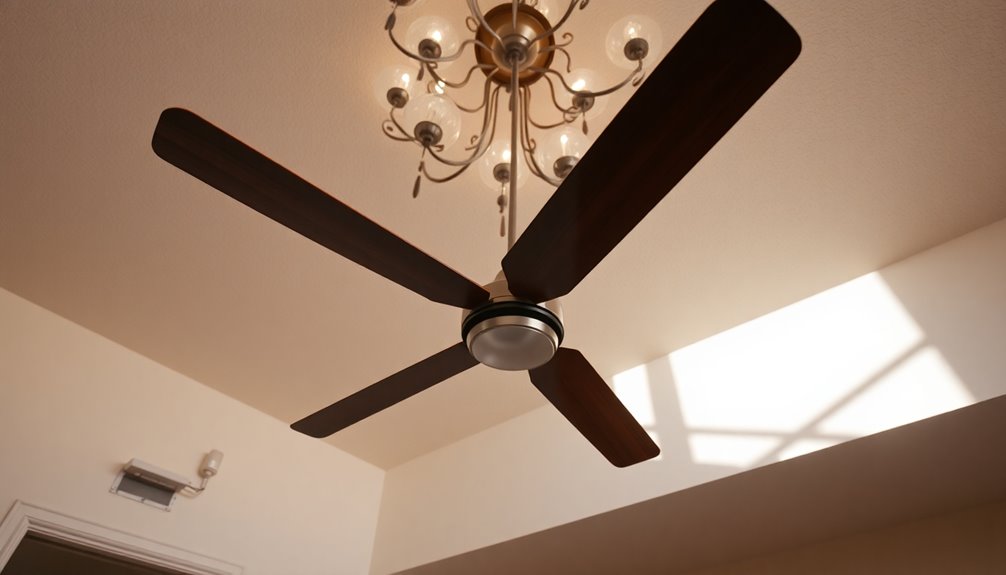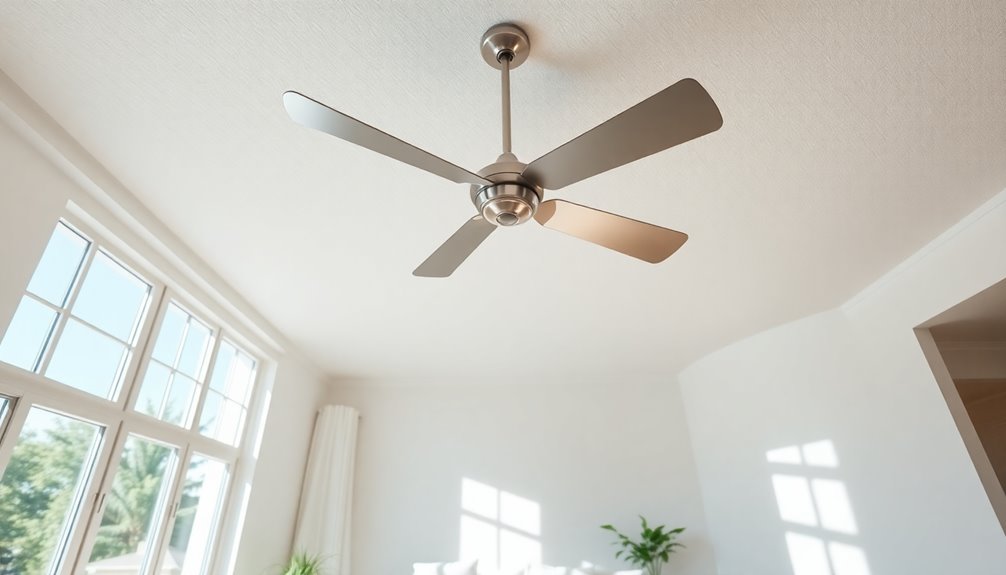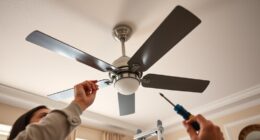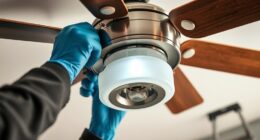A ceiling fan wobbles for several reasons that you can easily check. Loose screws on the blades or mounting bracket can disrupt its balance, causing that annoying shake. Warped blades, often due to environmental factors, will also lead to instability. Even dust accumulation can create uneven weight, exacerbating the wobble. If your fan was improperly installed or not secured to a fan-rated electrical box, that could be your culprit. Regular maintenance like checking screws and cleaning dust is essential to keep everything stable. Keep going to discover more tips and solutions to fix your fan's wobbly issue!
Key Takeaways
- Loose screws on the blades or mounting bracket can lead to instability and wobbling in ceiling fans.
- Warped blades caused by environmental factors or wear disrupt balance and contribute to wobbling.
- Dust accumulation on blades creates uneven weight distribution, exacerbating the wobbling effect.
- Improper installation, such as using non-fan-rated electrical boxes, can result in significant wobbling issues.
- Regular maintenance, including cleaning and checking screws, is essential to prevent wobbling problems in ceiling fans.
Common Causes of Wobbling

Wobbling ceiling fans can be a frustrating nuisance, but understanding the common causes can help you fix the issue. One of the primary culprits behind a wobbly ceiling fan is loose screws. If the screws securing the blades or the mounting bracket aren't tightened, your fan won't maintain proper equilibrium, leading to noticeable wobbling.
Warped blades can also contribute to instability, often caused by environmental factors or wear over time.
Another factor is dust and dirt accumulation, which can create uneven weight distribution on the blades, exacerbating the wobble. If you've recently installed your fan, improper installation may be to blame. Using a non-fan-rated electrical box or not securing the mounting hardware properly can lead to significant wobbling issues.
Regular maintenance is key to preventing these problems. Cleaning your fan and checking for loose screws should be part of your routine.
If you find that your fan still wobbles after checking these aspects, consider using a ceiling fan balancing kit. If you're unsure, don't hesitate to reach out to customer service for assistance. They can provide guidance tailored to your specific situation.
Identifying Imbalance Issues

A well-functioning ceiling fan should spin smoothly, but an imbalance can cause it to wobble, making it essential to identify the root of the issue.
Here are some key factors to evaluate when diagnosing a wobbling ceiling fan:
- Loose Screws: Check the screws securing the blades. If they're loose, it can disrupt the fan's equilibrium and lead to wobbling.
- Accumulated Dust: Dust buildup on one side of the fan blades can add weight unevenly, causing noticeable wobbling as the fan operates.
- Misalignment: Inspect for any misalignment of the blades. Warped blades or improper installation can create disparities in clearance from the ceiling, contributing to imbalance.
- Environmental Factors: Changes in humidity and temperature can warp fan blades, affecting uniform spacing and leading to wobbling issues.
Regular inspections for warped blades and ensuring uniform spacing can help catch these imbalance issues before they escalate.
Importance of Proper Installation

Identifying and addressing imbalance issues is just the starting point for guaranteeing your ceiling fan operates smoothly. Proper installation is vital to prevent wobbling and enhance safety.
Verify your fan is securely attached to a fan-rated electrical box, which is designed to support its weight. During installation, maintain a minimum distance of 8-10 inches between the fan blades and the ceiling to promote ideal airflow and stability.
Additionally, the bracket housing must be tightly secured. Loose mounting hardware can lead to wobbling over time, so it's important to check and tighten these connections regularly.
Installing your ceiling fan in a level position is critical; an uneven installation creates imbalances that can cause excessive wobbling.
Lastly, confirm that the electrical box can support the weight of your ceiling fan. This precaution helps prevent future issues stemming from structural failure, which could compromise the fan's stability.
Maintenance to Prevent Wobbling

To keep your ceiling fan operating smoothly and prevent wobbling, regular maintenance is vital. A wobbly ceiling fan can be annoying, but with a few simple tasks, you can guarantee it runs efficiently.
Here are four key maintenance tips to follow:
- Regular Cleaning: Dust accumulation on the blades can lead to imbalance. Use a soft cloth to clean your fan blades regularly.
- Tightening Screws: Periodically check and tighten screws and hardware. Loose components can cause wobbling and affect the fan's performance.
- Inspect Blade Alignment: Measure the distance between the blades and the ceiling. Confirm proper alignment to avoid any misalignment issues that could lead to wobbling.
- Use a Blade Balancing Kit: If you notice persistent wobbling, a blade balancing kit can help adjust weight distribution, correcting the imbalance.
Performing these maintenance checks at least once a year can catch early signs of wear and tear, preventing more significant wobbling problems down the line.
Professional Help and Solutions

When your ceiling fan continues to wobble despite your best DIY efforts, seeking professional help can be the best solution.
Professionals bring expertise that guarantees proper diagnosis of any underlying issues. They can assess the installation quality and structural integrity of your ceiling fan, identifying problems that mightn't be visible to you.
If the wobbling is due to the fan's components or its mounting, a professional can recommend high-quality replacement fans if necessary. This guarantees long-term stability and performance, eliminating persistent issues.
In addition, professional servicing often includes lubrication of motor components, which can alleviate noise and improve overall function. Regular maintenance can help prevent dangerous situations related to mechanical failures.
Regular maintenance by professionals can greatly extend the lifespan of your ceiling fans, preventing recurring wobbling issues. They can also provide guidance on how to maintain your fan effectively between visits.
By addressing the problem early and effectively, you can enjoy a smoother, quieter fan that enhances your comfort without the frustration of wobbling.
Frequently Asked Questions
How Do I Stop My Ceiling Fan From Wobbling?
To stop your ceiling fan from wobbling, start by checking that all blade screws are tight.
Use a measuring tape to verify each blade's distance from the ceiling is even.
Clean the blades to remove dust, which can cause imbalances.
Consider using a ceiling fan balancing kit to adjust weight distribution.
If it still wobbles, inspect the motor and mounting bracket for loose connections or wear needing professional help.
How Do You Fix a Ceiling Fan That Is Out of Balance?
Fixing a ceiling fan that's out of balance is like tuning a guitar; every part needs to harmonize.
Start by checking that all blades are securely attached and that screws are tight. Measure the distance from each blade to the ceiling to verify they're even.
If wobbling persists, use a blade balancing kit to pinpoint trouble spots.
Don't forget to clean the blades regularly to keep everything spinning smoothly.
Will a Ceiling Fan Fall if It Wobbles?
If your ceiling fan wobbles, it doesn't necessarily mean it'll fall, but it's a warning sign. You should address the wobbling promptly, as excessive movement can loosen screws or mounting hardware over time.
While a correctly installed fan is less likely to drop, ongoing wobbling can lead to safety risks and mechanical failure.
Regular maintenance and inspections can help guarantee your fan stays secure and operates smoothly, preventing potential accidents.
How Do I Stop a Fan From Moving Side to Side?
A ceiling fan shouldn't sway like a ship at sea. To stop it from moving side to side, first, check that all blades are securely attached and the screws are tight.
Measure the distance from each blade to the ceiling to guarantee even spacing. Clean the blades regularly to avoid dust buildup.
If wobbling persists, use a ceiling fan balancing kit to adjust the weight distribution and regain stability.
Conclusion
In the end, a wobbling ceiling fan can be a nuisance, but it's often a simple fix. Remember, "a stitch in time saves nine"—addressing imbalance, installation, and maintenance promptly can save you from bigger headaches down the line. Keep an eye on your fan's performance and don't hesitate to seek help if needed. With a little effort, you can enjoy a smooth, invigorating breeze without the distraction of wobbling blades.

